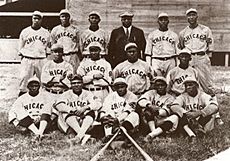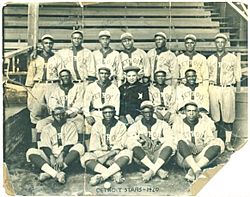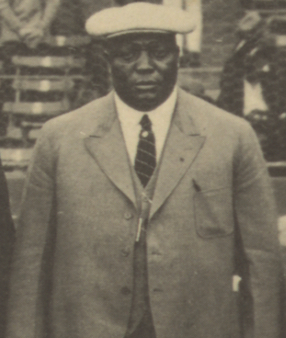Rube Foster facts for kids
Quick facts for kids Rube Foster |
|||
|---|---|---|---|
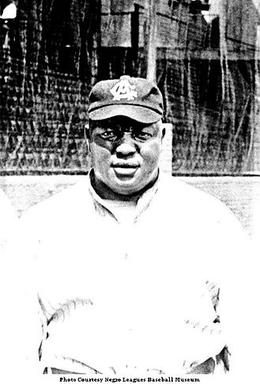 |
|||
| Pitcher/Manager/Owner | |||
| Born: September 17, 1879 Calvert, Texas, US |
|||
| Died: December 9, 1930 (aged 51) Kankakee, Illinois, US |
|||
|
|||
| debut | |||
| 1902, Chicago Union Giants | |||
| Last appearance | |||
| 1917, Chicago American Giants | |||
| Career statistics | |||
| Managerial record | 336–195–11 | ||
| Teams | |||
As Player
As Manager
|
|||
| Career highlights and awards | |||
|
|||
| Induction | 1981 | ||
| Election Method | Veterans Committee | ||
Andrew "Rube" Foster (born September 17, 1879 – died December 9, 1930) was an important figure in baseball. He was a player, manager, and leader in the Negro leagues. These leagues were professional baseball organizations for African-American players. In 1981, Rube Foster was honored by being elected into the Baseball Hall of Fame.
Many historians believe Foster was the best African-American pitcher in the early 1900s. He also started and managed the Chicago American Giants, which became one of the most successful Black baseball teams. Most importantly, he created the Negro National League. This was the first long-lasting professional league for Black baseball players. It operated from 1920 to 1931. Because of his huge impact, he is often called the "father of Black Baseball." Foster later made his nickname, "Rube," his official middle name.
Contents
Rube Foster's Early Baseball Career
Rube Foster was born in Calvert, Texas, on September 17, 1879. His father, also named Andrew, was a reverend. Foster began his professional baseball journey in 1897 with the Waco Yellow Jackets. This was an independent Black team.
Over the next few years, Foster became well-known among both Black and white baseball fans. In 1902, he joined the Chicago Union Giants, a top Black baseball team. After a brief struggle, he played for a white semi-pro team called the Otsego Independents. He had a good record there, winning eight games and striking out many batters. Later that season, he joined the Cuban X-Giants of Philadelphia. This team was considered one of the best in Black baseball.
In 1903, Foster became the star pitcher for the X-Giants. He helped them win the eastern Black championship. He personally won four games in that series.
How Rube Foster Got His Nickname
Foster earned his famous nickname "Rube" after beating a famous white pitcher named Rube Waddell. This happened in an exhibition game sometime between 1902 and 1905. A newspaper article from 1904 first called him "Rube." Research shows they likely played on August 2, 1903. Foster won that game against Waddell.
In 1904, Foster joined the Philadelphia Giants. He was a star by then. During that year, he won 20 games and pitched two no-hitters. He also helped the Philadelphia Giants win the Black championship against his old team, the Cuban X-Giants. In 1905, Foster had an amazing season. He led the Giants to another championship. A newspaper called him the best pitcher ever. The Philadelphia Giants later helped create a new league with both Black and white teams.
Leading the Leland Giants
In 1907, Foster became the playing manager for the Chicago Leland Giants. He and other star players left the Philadelphia Giants to join this team. Under Foster's leadership, the Lelands had an incredible season. They won 110 games and lost only ten. They also won the Chicago City League pennant. The next year, the Lelands tied a national championship series.
In 1909, Foster broke his leg. But he quickly returned to play in a series against the Chicago Cubs. The Lelands lost that series. In 1910, Foster took full control of the team. He built what he called his best team ever. He signed talented players like John Henry Lloyd. The Lelands had an amazing record of 123 wins and only 6 losses that year. Foster himself contributed a 13-2 pitching record.
Creating the Chicago American Giants
The next year, Foster partnered with John Schorling. Schorling was related to the owner of the Chicago White Sox. Foster's team was allowed to use the White Sox's old stadium. This stadium became known as Schorling's Park. The Leland Giants then changed their name to the Chicago American Giants. For the next four years, the American Giants were champions of western Black baseball.
By 1915, the Indianapolis ABCs became a strong rival. They defeated the American Giants in a series. This led to arguments about who was the true western champion. These disagreements showed the need for a formal Black baseball league.
Foster as a Manager and Teacher
By 1915, Foster was pitching less and less. After 1917, he focused entirely on managing the team. As a manager and team owner, Foster was very strict. He controlled every part of the game. He expected his players to act professionally and look their best.
Schorling Park was a very large field. So, Foster taught his team to play a certain way. They focused on speed, bunting, and hitting the ball to specific spots. He also emphasized strong pitching and defense. Foster was also a great teacher. Many of his players later became managers themselves. In 1919, Foster helped start a new team in Detroit, the Stars. He even sent some of his best players there. This helped set the stage for the creation of the Negro National League the following year.
Founding the Negro National League
In 1920, Rube Foster and other team owners met. They decided to create a professional baseball league for African-American teams. This became the Negro National League (NNL). Foster was the president of the league. He also continued to own and manage the American Giants.
Some people thought Foster favored his own team. For example, his team often had more home games. He also seemed to get the best players from other teams. However, Foster also helped other teams. If a team was losing money, he would sometimes help them pay their players. This showed his dedication to the league's success.
His American Giants won the NNL's first three championships. In 1923, some eastern teams left the NNL. They formed their own league, the Eastern Colored League (ECL). Eventually, the two leagues agreed to respect each other's player contracts. They also decided to play a World Series against each other.
After a few years, Foster made big changes to his team in 1925. He let go of several older players. In May 1925, Foster became unwell. His health continued to decline. By 1926, his behavior became unpredictable. He had to leave baseball midway through the 1926 season. He was cared for in Kankakee, Illinois.
Even without Foster, the American Giants continued to play. They won the championship and World Series in 1926 and 1927. But the league struggled without Foster's strong leadership. Rube Foster passed away in 1930. The league he founded ended a year later.
Thousands of people attended Foster's funeral in Bronzeville, Chicago. His coffin was closed at the time a baseball game usually ends. He is buried in Lincoln Cemetery in Blue Island, Illinois.
Rube Foster's Legacy
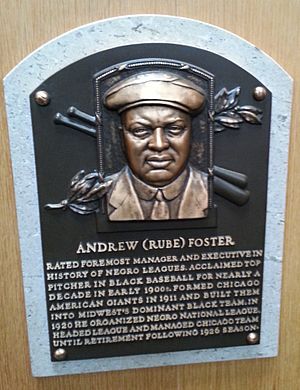
In 1981, Rube Foster was elected to the National Baseball Hall of Fame. He was the first person from the Negro leagues to be chosen as a pioneer or executive.
In 2010, the U.S. Postal Service released special postage stamps. These stamps honored Negro leagues Baseball. One of the stamps features Rube Foster.
The Negro Leagues Baseball Museum holds an annual event called the Andrew "Rube" Foster Lecture. This lecture celebrates his contributions to baseball. In 2021, Rube Foster was also inducted into the Chicagoland Sports Hall of Fame. Also in 2021, the United States Mint announced new commemorative coins. These coins honor the Negro Leagues Centennial. Rube Foster is featured on the $5 gold coin.


